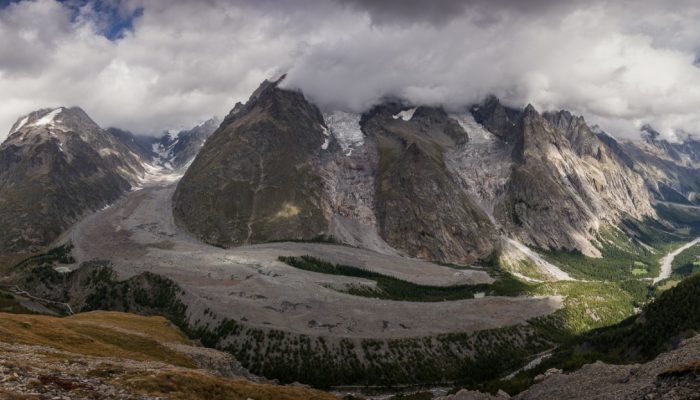
In a world where climate change causes many mountain glaciers to shrink away, bucking the ‘melting’ trend is not easy. In today’s post, Antonello Provenzale, a researcher in Italy, tells us of one glacier in the Alps which is doing just that.
Mountain glaciers are retreating worldwide, with the possible exception of the Karakoram area. For most glaciers, ablation (ice melt) during the warm season is stronger than the accumulation of new ice by snowfall. As a result, while glacier ice flows downhill, the accelerated melting at lower elevation forces the terminus of the glacier to retreat uphill, with a net loss of ice volume.
Such behavior is especially evident on the southern flank of the Alps, where many mountain glaciers have dramatically reduced their dimensions, often fragmenting into smaller, detached pieces.
An important exception is represented by the Miage glacier in Val Veny, Val d’Aosta, northwestern Italy, at the base of the Mount Blanc massif. This glacier is covered with a thick layer of debris, which protects the underlying ice from the direct heating by sunlight. The rocks which make up the debris are poor heat conductors and thus preserve the ice beneath them, making this glacier particularly stable.
This glacier is so stationary that vegetation and trees have grown on its margins and on the debris. Several ponds punctuate the surface of the glacier, as well as some areas on its sides. The Miage lake, for example, is directly in contact with the slowly flowing ice and it is sometimes run by large outburst waves generated by huge blocks of ice and rock falling into the lake water.
This picture was taken in September 2014, during a field excursion of the Italian Glaciological Committee. The image is a composition (stitch) of several images taken with a moderate wide angle lens on a rangefinder digital camera.
By Antonello Provenzale studies Geophysical Fluid Dynamics, Earth System processes and Geosphere-Biosphere interactions at the Institute of Geosciences and Earth Resources of the National Research Council of Italy.
Imaggeo is the EGU’s online open access geosciences image repository. All geoscientists (and others) can submit their photographs and videos to this repository and, since it is open access, these images can be used for free by scientists for their presentations or publications, by educators and the general public, and some images can even be used freely for commercial purposes. Photographers also retain full rights of use, as Imaggeo images are licensed and distributed by the EGU under a Creative Commons licence. Submit your photos at http://imaggeo.egu.eu/upload/.




